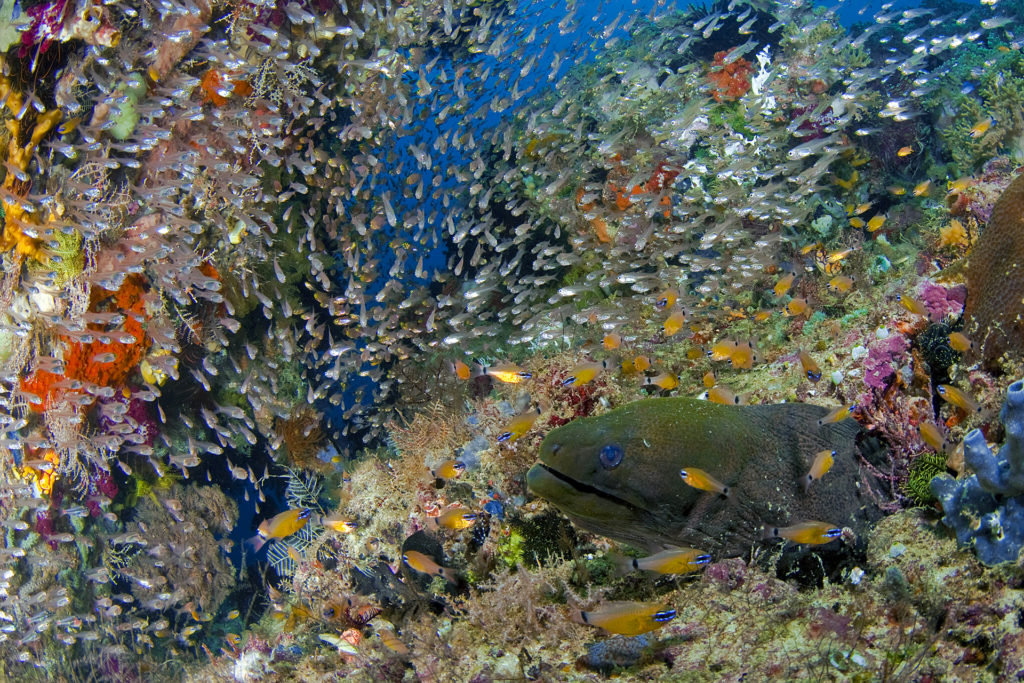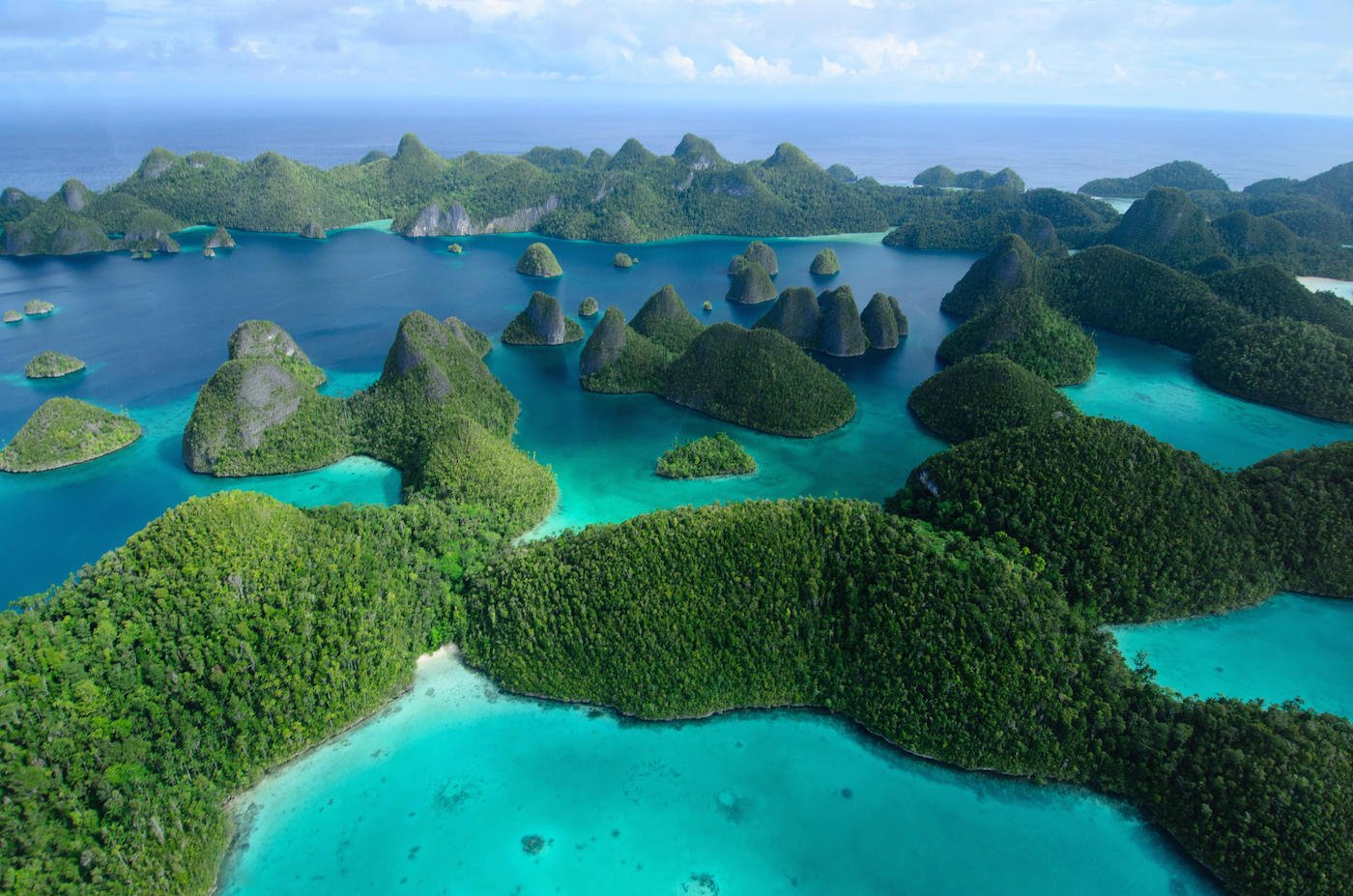ABOUT RAJA AMPAT INDONESIA – Four Kings
Papua Explorers Eco Resort is located in the islands of Raja Ampat, which is on the northwest tip of the Bird’s Head Peninsula of West Papua. Raja Ampat translates into English as Four Kings. The name comes from a local mythology that tells about a woman who finds seven eggs. Four of the seven eggs hatch and become kings that occupy four of Raja Ampat biggest islands. These are Salawati, Batanta, Waigeo and Misool. Whilst the other three eggs in the mythology become a ghost, a woman, and a stone.
Raja Ampat is a stunning archipelago comprising over 1,500 small islands. These host thousands of species some of which are endemic to the region. It’s a relatively new regency which separated from Sorong Regency in 2004. It encompasses more than 40,000 km² of land and sea. This also contains Cenderawasih Bay, the largest marine national park in Indonesia. It is a part of the newly named West Papua (province) of Indonesia which was formerly Irian Jaya.
The famous Dampier Strait is a wide water channel that separates the Raja Ampat islands of Waigeo and Batanta. Here we find the most popular dive sites of Raja Ampat with their stunning beauty. It is named after British navigator William Dampier. Our resort is directly at the coast of the Dampier Strait, in the south of Gam island.
Raja Ampat Population and Communities
History shows that it was once a part of Tidore Kingdom, an influential kingdom from Maluku. Yet, after the Dutch invaded Maluku, the Netherlands claimed it shortly. The people of Raja Ampat live in small settlements that are spread around the area. Although traditional culture still strongly exists, they are very welcoming to visitors. Their religion is dominantly Christian and almost every village has a small church.
The main occupation for people around this area has been fishing, since the sea dominates the area. The lifestyle in the villages of Raja Ampat is simple and many of the inhabitants are children. Therefore, it is so important to us to improve the livelihood of local communities. Empower them in our journey of conservation and sustainable tourism is equally significant. We invest in a sustainable, long-term relationship with our neighboring village Yenwaupnor and other surrounding villages of Raja Ampat.
The majority of our employees come from the Raja Ampat area. We train them in various roles, such as dive guides, captains, cooks, carpenters, electricians, wood carvers and boat builders. Further, our Sunday school provides children an interesting environment to learn English, math, geography and conservation. We conduct field trips to clean up beaches and compare healthy reefs with unhealthy reefs. Further snorkel sessions with sharks and mantas provide a great opportunity for these kids. It helps them to understand the value of their home, so they can protect it for the coming generations.
Raja Ampat Biodiversity
Raja Ampat’s Biodiversity is legendary but not unexplainable. The region is located right at the center of the so-called Coral Triangle. It is a roughly triangular area of the tropical marine waters. The area includes parts of Indonesia, Malaysia, Papua New Guinea, Philippines, Solomon Islands and Timor-Leste. It contains at least 500 species of reef-building corals.
The Coral Triangle is recognized as the worldwide epicenter of marine biodiversity. Not only for corals and fish, but many other marine organisms as well and therefore a global priority for conservation. The region covers only a very small portion of the planet’s oceanic area. Yet, it has the majority of all known coral species in the world. It is habitat for roughly half of all Indo-Pacific reef fishes and almost half of the world’s reef fishes. Therefore, it encompasses the highest diversity of coral reef fishes in the world. More than 3000 species of fish live in the Coral Triangle. It also provides habitat to six out of the world’s seven marine turtle species.
Raja Ampat’s biodiversity in numbers: More than 1,300 species of coral reef fish. Five species of rare and endangered sea turtles including the hawksbill sea turtle. 600 species of hard coral within the Bird’s Head Seascape—75% of the total for the entire world. 13 marine mammal species including the dugong. 700 species of mollusk—including 7 giant clam species. 57 species of mantis shrimp within the Bird’s Head Seascape.
Above the Water
The Raja Ampat islands are mostly made of limestone. Many of the smaller islands have rough shapes looking like little mushrooms during low tide. That is because sea water steadily hollows out the lower parts. Despite the rough structure, tropical trees have found nooks and crannies to place their roots. So they provide a habitat for various bird species even on tiny islands.
On the larger islands of Raja Ampat Indonesia we find lush rainforests with majestic trees. Also many other tropical plants, for example wild orchids. Some islands have waterfalls and small mountain ridges. In these forests we can discover further tropical bird species as well as bats and various butterflies. The jungles of Raja Ampat are also home of the endemic Birds of Paradise famous for their amazing mating ceremonies. We can observe the two species Red Bird of Paradise and Wilson’s Bird of Paradise on dedicated bird watching hikes.
The British explorer and biologist Alfred Russel Wallace visited Raja Ampat in the 19th century already. Wallace is known for independently conceiving the theory of evolution through natural selection. He was fascinated by Raja Ampat’s beauty (above the water, as diving hadn’t been invented yet). With his fieldwork in Raja Ampat and other areas of Indonesia Wallace identified the faunal divide, the Wallace Line. It separates the Indonesian archipelago into two distinct parts. Firstly, the western portion in which the animals are largely of Asian origin. And secondly the eastern portion where the fauna reflects Australasia.
Climate and Seasons
Sea and weather temperatures are stable all year round in the Raja Ampat islands. This makes it very easy to plan your journey. The sea temperature is between 28°C and 29°C all year. Historical weather temperature averages are 30°C during the day and 24°C during the evening. Raja Ampat Indonesia has two seasons and the direction of the wind dominates these rather than the rain. Like many tropical places, Raja Ampat is rainy all year round with tropical showers and sunshine within the same day.
See also: When is the best time to visit Raja Ampat



 Deutsch
Deutsch Français
Français
